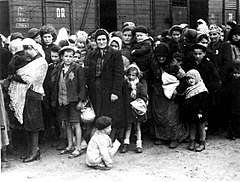List of Nazi ghettos
This article is a partial list of selected Jewish ghettos created by the Nazis for the purpose of isolating, exploiting and finally, eradicating Jewish population (and sometimes Gypsies) on territories they controlled. Most of the prominent ghettos listed here were set up by the Third Reich and its allies in the course of World War II. In total, according to USHMM archives, "The Germans established at least 1,000 ghettos in German-occupied and annexed Poland and the Soviet Union alone." Therefore, the examples are intended only to illustrate their scope across Eastern and Western Europe.[2]
 The World War II ghettos established by Nazi Germany in which Jews were confined existed across the continent; their inmates were later shipped to Nazi concentration camps
|
In Europe
Large Nazi ghettos in which Jews were confined existed across the continent. These ghettos were liquidated mostly by Holocaust transports to concentration and extermination camps built by Nazi Germany in occupied Poland.[1]
German-occupied Poland
Following the 1939 Invasion of Poland, the new ghetto system had been imposed by Nazi Germany roughly between October 1939 and July 1942 in order to confine Poland's Jewish population of 3.5 million for the purpose of persecution, terror, and exploitation.[3] The Warsaw Ghetto was the largest ghetto in all of Nazi occupied Europe, with over 400,000 Jews crammed into an area of 3.4 square kilometres (1 3⁄8 square miles), or 7.2 persons per room.[4] The Łódź Ghetto was the second largest, holding about 160,000 inmates.[5]
A more complete list of over 270 ghettos with an approximate number of prisoners, dates of creation and liquidation, as well as known deportation routes to Extermination camps, is available at Jewish ghettos in German-occupied Poland. Below, selected Nazi German designations, in brackets.
| Part of a series on | ||||||||||
| The Holocaust | ||||||||||
|---|---|---|---|---|---|---|---|---|---|---|
 Jews on selection ramp at Auschwitz, May 1944 | ||||||||||
|
||||||||||
|
Camps
|
||||||||||
|
Atrocities |
||||||||||
|
|
||||||||||
|
Reparations Agreement between Israel and West Germany |
||||||||||
|
Resources Functionalism versus intentionalism |
||||||||||
- Baranowicz Ghetto
- Będzin Ghetto, site of Będzin Ghetto Uprising
- Białystok Ghetto, site of Białystok Ghetto uprising
- Brześć (Brest-Litovsk) Ghetto
- Buczacz Ghetto
- Częstochowa Ghetto, site of Częstochowa Ghetto uprising
- Czortków Ghetto
- Drohobycz Ghetto
- Grodno Ghetto
- Izbica Ghetto
- Kielce Ghetto
- Kolomyja Ghetto
- Kraków (Krakau) Ghetto
- Łachwa Ghetto, site of Łachwa Ghetto uprising
- Lida Ghetto
- Łódź (Litzmannstadt) Ghetto
- Łomża Ghetto
- Lubartów Ghetto
- Lublin Ghetto
- Łuck Ghetto, site of Łuck Ghetto uprising and massacre
- Lwów (Lemberg) Ghetto, site of Lviv pogroms
- Marcinkance (Marcinkonys) Ghetto
- Międzyrzec Podlaski (Mezritsh) Ghetto
- Mińsk Mazowiecki (Novominsk) Ghetto
- Mizocz Ghetto
- Nowogródek Ghetto
- Nowy Sącz Ghetto (20 Jews assigned to one room)
- Opatów Ghetto in Opatów
- Pińsk (Pinsk) Ghetto
- Piotrków Trybunalski (Petrikau) Ghetto
- Radom Ghetto
- Sambor Ghetto, see rescue by Franciscan Sisters of the Family of Mary
- Siedlce Ghetto, see the November 1942 massacre at Gęsi Borek
- Słonim Ghetto, site of Słonim Ghetto uprising
- Sosnowiec (Sosnowitz) Ghetto, site of Sosnowiec Ghetto uprising
- Stanisławów (Stanislau) Ghetto, site of Bloody Sunday massacre
- Stryj Ghetto
- Tarnopol Ghetto with satellite labour camps
- Tarnów Ghetto
- Trochenbrod (Zofiówka) Ghetto
- Vilna (Wilno, Vilnius) Ghetto, site of Ponary massacre
- Warsaw (Warschau) Ghetto, site of Warsaw Ghetto Uprising
- Zdzięcioł (Djatlowo) Ghetto, site of Dzyatlava massacre
Other occupied countries
- Baia Mare Ghetto
- Bershad Ghetto
- Bistrița Ghetto
- Budapest Ghetto
- Bytom (Beuthen) Ghetto
- Bobruisk Ghetto
- Borisov Ghetto
- Berdichev Ghetto
- Borshchiv Ghetto
- Cehei Ghetto
- Czernowitz Ghetto, Romanian-operated
- Cluj (Kolozsvár) Ghetto
- Daugavpils (Dvinsk) Ghetto
- Dej Ghetto
- Gomel Ghetto
- Karlovac Ghetto, Croatia
- Kovno (Kaunas) Ghetto
- Liepāja Ghetto
- Minsk Ghetto
- Mogilev Ghetto
- Monastir Ghetto, Bulgarian-operated
- Olyka Ghetto, Ukraine
- Oradea Ghetto
- Polotsk Ghetto
- Pruzhany Ghetto
- Reghin Ghetto
- Riga Ghetto
- Salonika Ghetto
- Satu Mare Ghetto
- Sfântu Gheorghe Ghetto
- Šiauliai Ghetto, Lithuania
- Sighet Ghetto
- Slutsk Ghetto
- Smolensk Ghetto
- Švenčionys Ghetto
- Theresienstadt Ghetto (concentration camp, sometimes referred to as a ghetto)
- Vitebsk Ghetto
- Zagreb Ghetto, Ustaše-operated
- Zhitomir Ghetto
Ghettos outside Europe
- Shanghai Ghetto (1937-1941 Less Restriction over Jews by Japanese) (1942-1945) Japanese forced 16,000 Jews into a one square mile Ghetto, where they were often the victims of air raids by the U.S.' 7th Air Force, and often had no running water, no bathroom, heavy rations, and it was not uncommon for 30-40 people to sleep in the same room. [6]
References
- The Ghettos. Yad Vashem The Holocaust Martyrs' and Heroes' Remembrance Authority
- Types of Ghettos. United States Holocaust Memorial Museum, Washington, D.C.
- The statistical data compiled on the basis of "Glossary of 2,077 Jewish towns in Poland" Archived 2016-02-08 at the Wayback Machine by Virtual Shtetl Museum of the History of the Polish Jews (in English), as well as "Getta Żydowskie," by Gedeon, (in Polish) and "Ghetto List" by Michael Peters at www.deathcamps.org/occupation/ghettolist.htm (in English). Accessed June 21, 2011.
- Warsaw Ghetto, United States Holocaust Memorial Museum (USHMM), Washington, D.C.
- Ghettos, United States Holocaust Memorial Museum
- Shanghai Jewish History Archived 2010-05-29 at the Wayback Machine, Proclamation Concerning Restriction of Residence and Business of Stateless Refugees. (Shanghai Jewish Center)
Bibliography
- Megargee, Geoffrey P., ed. (2012). Encyclopedia of Camps and Ghettos, 1933–1945. in association with United States Holocaust Memorial Museum. Bloomington: Indiana University Press. ISBN 978-0253355997.
- Spector, Shmuel; Wigoder, Geoffrey, eds. (2001). The Encyclopedia of Jewish Life Before and During the Holocaust. New York: New York University Press. ISBN 978-0814793565.